Section 2 | Anthelmintic Resistance in Sheep & Goats
Ontario Sheep & Goat
Industry
Page 09 /
Industry
Page 09 /
Management Strategies to Reduce the Impact of GIN Infections
The University of Guelph and the Ontario Ministry of Agriculture, Food and Rural Affairs has created the 5 Star Worm Plan to control parasites in sheep and goat flocks/herds. The goal of this plan is to minimize the impact that parasites have on animal health and productivity, while preventing the development of anthelmintic resistance. The five components of the plan include:
- Managing the Level of Pasture Contamination
- Using Anthelmintics Appropriately
- Monitoring and Treating Animals Selectively
- Quarantining and Treating New Introductions
- Investigating Treatment Failure

Source: Ontario Sheep
Managing the Level of Pasture Contamination
Several factors must be taken into consideration to manage the level of contamination on a given pasture:
- Sources of contamination
- The main sources of pasture contamination are lambs and kids (mid to late grazing season) and adult females (spring turnout). To manage the level of contamination, the adults should be selectively treated and youngstock should be monitored frequently to determine when a treatment is necessary
- Break up fecal pellet to destroy L1 and L2 larval stages (these stages live in manure on pasture)
- Modify grazing based on height of pasture grass
- Because infective larvae (L3) usually do not migrate higher than 4-6 inches on grass, managing pastures to minimize grazing below that level can reduce exposure to larvae
- Avoid spreading contaminated manure on grazing pasture field
- Move animals before eggs hatch and larvae become infective (L3), and do not return animals to the pasture before L3 have died (in colder weather)
- Maintain low stocking densities to reduce exposure to larvae

References
- Mederos, A., S. Fernandez, J. VanLeeuwen, A.S. Peregrine, D. Kelton, P. Menzies, A. LeBoeuf, and R. Martin. 2010. Prevalence and distribution of gastrointestinal nematodes on 32 organic and conventional commercial sheep farms in Ontario and Quebec, Canada (2006-2008). Veterinary Parasitology. 170:244-252.
- Mavrot, F., H. Hertzberg, and P. Torgerson. 2015. Effect of gastro-intestinal nematode infection on sheep performance: a systematic review and meta-analysis. Parasit. Vectors. 8:557.
- Bath, G.F., and J.A. van Wyk. 2009. The Five Point Check for targeted selective treatment of internal parasites in small ruminants. Small Ruminant Research. 86:6-13.
- Fleming, S.A., T. Craig, R.M. Kaplan, J.E. Miller, C. Navarre, and M. Rings. 2006. Anthelmintic resistance of gastrointestinal parasites in small ruminants. J. Vet. Intern.
Med. 20:435-444.